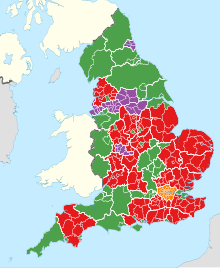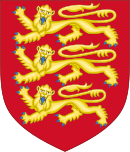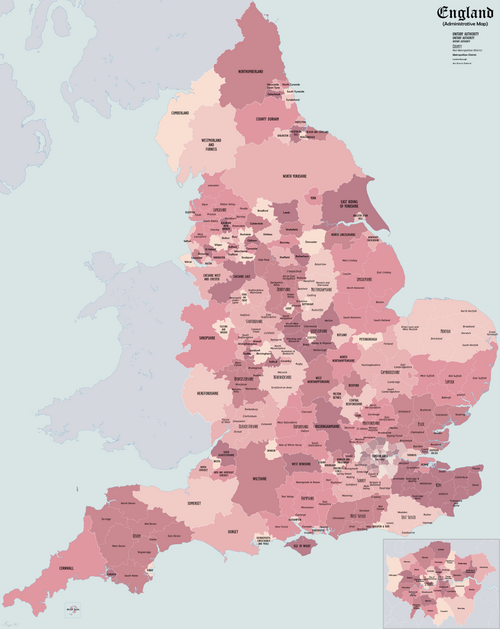| Local authority district | |
|---|---|
 | |
| Category | Administrative district |
| Location | England |
| Found in | Counties |
| Created by | Local Government Act 1972 London Government Act 1963 |
| Created |
|
| Number | 296 (as of 2022) |
| Possible types |
|
| Possible status | |
| Populations | 2,300 – 1.1 million |
| Areas | 3 – 5,013 km (1 – 1,936 sq mi) |
| This article is part of a series within the Politics of the United Kingdom on the |
| Politics of England |
|---|
 |
|
The Crown
|
| Governance |
|
Legislative
|
ElectionsUK General Elections in England
|
| Judiciary |
| Regions |
| Administration |
The districts of England (officially, local authority districts, abbreviated LADs) are a level of subnational division of England used for the purposes of local government. As the structure of local government in England is not uniform, there are currently four principal types of district-level subdivision. There are a total of 296 districts made up of 36 metropolitan boroughs, 32 London boroughs, 164 two-tier non-metropolitan districts and 62 unitary authorities, as well as the City of London and the Isles of Scilly which are also districts but do not correspond to any of these other categories. Some districts are styled as cities, boroughs or royal boroughs; these are purely honorific titles and do not alter the status of the district or the powers of their councils. All boroughs and cities (and a few districts) are led by a mayor who in most cases is a ceremonial figure elected by the district council, but—after local government reform—is occasionally a directly elected mayor who makes most of the policy decisions instead of the council.
History
Main article: Subdivisions of EnglandBefore the establishment of districts in the 1890s, the basic unit of local government in England was the parish, overseen by the parish church vestry committee. Vestries dealt with the administration of both parochial and secular governmental matters. Parishes were the successors of the manorial system and historically had been grouped into hundreds, which had exercised some supervising administrative function. However, these powers ebbed away as more and more civic and judicial powers were centred on county towns. From 1834 these parishes were grouped into Poor Law Unions, creating areas for administration of the Poor Law. These areas were later used for census registration and as the basis for sanitary provision. In 1894, based on these earlier subdivisions, the Local Government Act 1894 created urban districts and rural districts as sub-divisions of administrative counties, which had been created in 1889. At the same time, parish-level local government administration was transferred to civil parishes. Another reform in 1900 created 28 metropolitan boroughs as sub-divisions of the County of London.
The setting-down of the current structure of districts in England began in 1965, when Greater London and its 32 London boroughs were created. They are the oldest type of district still in use. In 1974, metropolitan counties and non-metropolitan counties (also known as "shire counties") were created across the rest of England and were split into metropolitan districts and non-metropolitan districts.
The status of the London boroughs and metropolitan districts changed in 1986, when they absorbed the functions and some of the powers of the metropolitan county councils and the Greater London Council, which were abolished. Since 2000, powers are again shared (on a different basis) with the Greater London Authority.
During the 1990s a further kind of district was created, the unitary authority, which combined the functions and status of county and district.
Metropolitan boroughs
Main article: Metropolitan boroughMetropolitan boroughs are a subdivision of a metropolitan county. These are similar to unitary authorities, as the metropolitan county councils were abolished in 1986. Most of the powers of the county councils were devolved to the districts but some services are run by joint boards and organisations. The districts typically have populations of 174,000 to 1.1 million.
Non-metropolitan districts
Main article: Non-metropolitan districtNon-metropolitan districts are second-tier authorities, which share power with county councils. They are subdivisions of shire counties and the most common type of district. These districts typically have populations of 25,000 to 200,000.
In this two-tier system, county councils are responsible for some local services, such as education, social services, and roads, while district councils run other services, such as waste collection, local planning, and council housing.
The number of two-tier non-metropolitan districts (also known as shire districts) has varied over time. Initially, there were 296; after the creation of single-tier unitary authorities in the 1990s, 2000s, 2010s and 2020s, their numbers were reduced to 164 by 2023.
Unitary authority areas
Main article: Unitary authorities of EnglandThese single-tier non-metropolitan districts are responsible for running all local services in their areas, combining county and district functions. They were first created in the mid-1990s, and often cover large towns and cities as this is deemed more efficient than a two-tier structure. In addition, some of the smaller counties such as Rutland, Herefordshire and the Isle of Wight are unitary authorities. There are a total of 62 unitary authorities, the latest ones introduced in 2023.
Unitary authority areas are a type of non-metropolitan district; most are established as individual counties containing a single district, with a district council but no county council. Cornwall, Durham, the Isle of Wight, Northumberland, Shropshire and Wiltshire were established as counties with a single district, but have non-metropolitan county councils with no district council. In practice, these function in the same way as other unitary authorities. Berkshire is unusual, being the only non-metropolitan county, with no county council, that has more than one unitary authority district within it, each of which is not a county.
Districts with their ceremonial or historic county in their names
London boroughs
Main article: London boroughsThe 32 London boroughs are sub-divisions of Greater London. They were established in 1965. Between 1965 and 1986 a two-tier structure of government existed in Greater London and the boroughs shared power with the Greater London Council (GLC). When the GLC was abolished in 1986 they gained similar status to the unitary authorities. In 2000 the Greater London Authority was established and a two-tier structure was restored, albeit with a change to the balance of powers and responsibilities.
Each London borough is responsible for many of the services within their area, such as schools, waste management, planning applications, social services, libraries and others.
Map

See also
- List of English districts
- List of English districts by population
- List of English districts by area
- List of English districts by population density
- List of English districts by ethnicity
- List of local governments in the United Kingdom
References
- "A Beginners Guide to UK Geography (2023)". Open Geography Portal. Office for National Statistics. 24 August 2023. Retrieved 9 December 2023.
- Mapping the Hundreds of England and Wales in GIS University of Cambridge Department of Geography, published 06-06-08, accessed 12 October 2011
| Links to related articles | |||||||||||||||||||||||||||||||||||||||||||||||||
|---|---|---|---|---|---|---|---|---|---|---|---|---|---|---|---|---|---|---|---|---|---|---|---|---|---|---|---|---|---|---|---|---|---|---|---|---|---|---|---|---|---|---|---|---|---|---|---|---|---|
| |||||||||||||||||||||||||||||||||||||||||||||||||